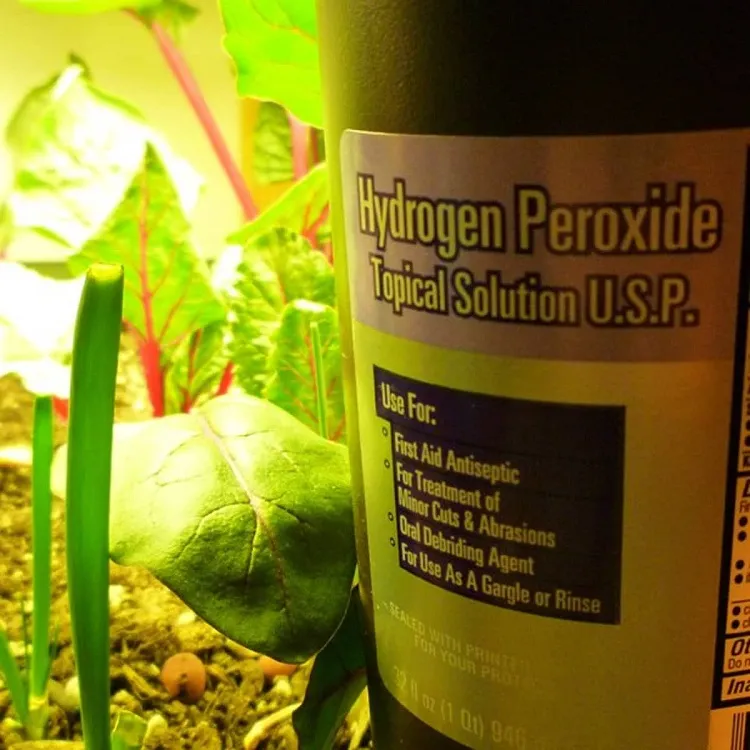Hydrogen peroxide, this colorless, but very reactive liquid, composed of water and oxygen, has been successfully utilized by some gardeners to enhance plant root health and fight against a number of diseases. It was shown that this natural substance can revive even dying plants, turning them back to life. What’s the proper technique to prepare and apply hydrogen peroxide for plant roots to leave them strong and healthy?
Is Hydrogen Peroxide Good for Plant Roots?
It’s evident that hydrogen peroxide is able to influence positively the plants, but you should practice this with precaution and temperance. This reactive substance is famous for its oxidizing and antimicrobial capabilities. When applied diluted in appropriate concentrations, it is helpful in removing harmful pathogens, aerating the soil, and boosting root growth. Many gardeners confess about successful usage of this substance solutions in treating root rot, enhance soil structure, and helping oxygen to reach the plant roots.
How to Utilize Hydrogen Peroxide for Plant Roots?
The secure use of hydrogen peroxide in gardening requires applying certain concentrations and suitable method. The proper concentration used in horticultural applications are in the diapason from 3% to 6%, which solutions can be found in the drugstores. Though, even at these low percents, you should dilute the solution once more before to pour it on plants. In most often cases of root treatment, the best ratio with water is around 1 teaspoon (5 ml) of 3% solution per 1 gallon (4 liters) of water. This mild concentration is enough to cure root diseases, promote nutrient uptake, and enhance the root health. It’s recommendable to pour this solution rarely, till the soil absorbs it without to hurt the plants.
Hydrogen Peroxide for Strawberry Plants Root Rot
One of the most remarkable uses of hydrogen peroxide for plant roots in gardening is its potential to combat rot in strawberry. It is caused by fungal disease, which infects multiple plant species, one of which is strawberry. Root rot appears when the soil becomes too damp, which is just a favorable environment for pathogen development. Hydrogen peroxide’s antifungal qualities aid in solving this issue. To use the solution for treating ill strawberry plants infested with root rot, follow these steps:
- Make a diluted solution: Pour 1 part 3% hydrogen peroxide into 4 parts water.
- Gently take the infected plant from the pot. Be careful not to injure at least the main roots.
- Trim away damaged roots. Cut away any notably ill or rotting roots.
- Soak the plant roots in the solution. Submerge the roots of the infected plant in a container filled with the diluted hydrogen peroxide solution for about 30 minutes. This action is likely to eliminate fungal pathogens.
- Take the plant out of the solution. Then allow it to drain from the liquid.
- Repot in new container. Place it in another pot with new, well-draining soil, with good aeration and drainage that will not allow further root rot.
! Be careful, knowing that prevention is most important. So, do not overwater and ensure good drainage to decrease the possibility of root rot appearance in strawberries or any other amenable to this disease species.
Read also: Why Strawberries Do Not Ripen? 4 Common Problems + Tips to Speed up Ripening
How Do You Revive a Dying Plant with Hydrogen Peroxide?
Seeing your beloved plant that deteriorate can be discouraging, though hydrogen peroxide for plant roots may turn it back to life. Although this is not a surefire solution, and it is not suited for all the particular circumstances, this natural substance can really help in reviving a dying plant and then recovering it. Let’s look through the guidelines of how to apply the solution to achieve this aim:
Evaluate the situation: Find out the reason of the plant’s regression. If it’s because of too much watering, insufficient drainage, or root problems, hydrogen peroxide could be beneficial.
Dilute the solution: Pour 1 teaspoon (5 ml) of 3% hydrogen peroxide in 1 gallon (4 liters) of water.
Gently take out the plant from its pot, removing the excess soil to set out the roots.
Prune damaged roots: Trim away any obviously rotten or compromised roots with sterilized scissors or pruning shears.
Infuse the roots: Soak the plant in a container with the diluted hydrogen peroxide solution for about 20–30 minutes. This action will disinfect the roots and increase the oxygen uptake.
Replant it in a new pot: Select a clean pot with enough large drainage holes, and fill it with fresh, well-draining soil. Replant the revived plant, ensuring the roots are positioned properly.
Pour the solution. Water the plant with the remaining solution, allowing it to absorb and be treated while the solution releases its oxygen.
Place the plant without direct light. Let the plant stay in a spot with mild temperature, avoiding direct sunlight during the recovery period.




